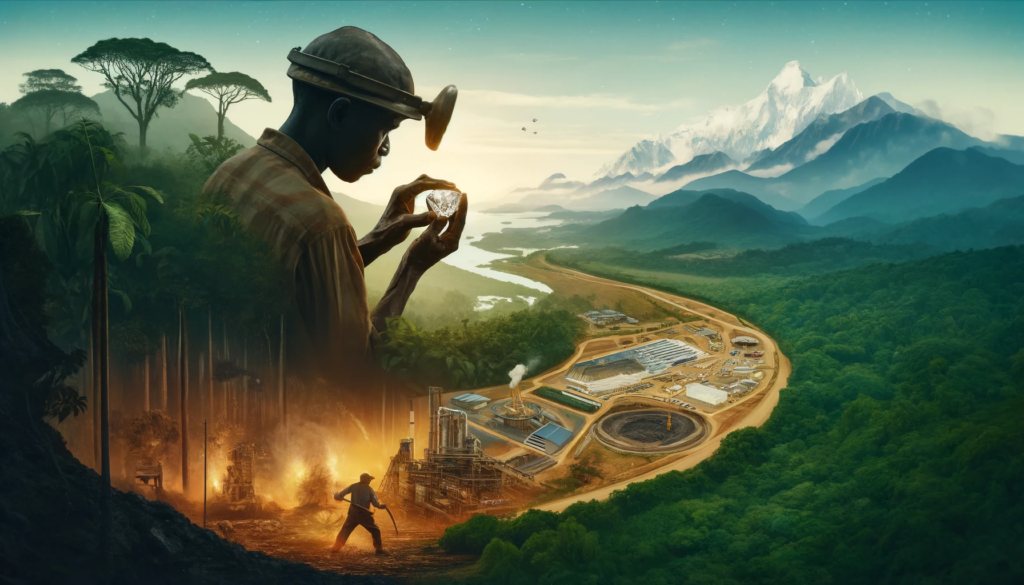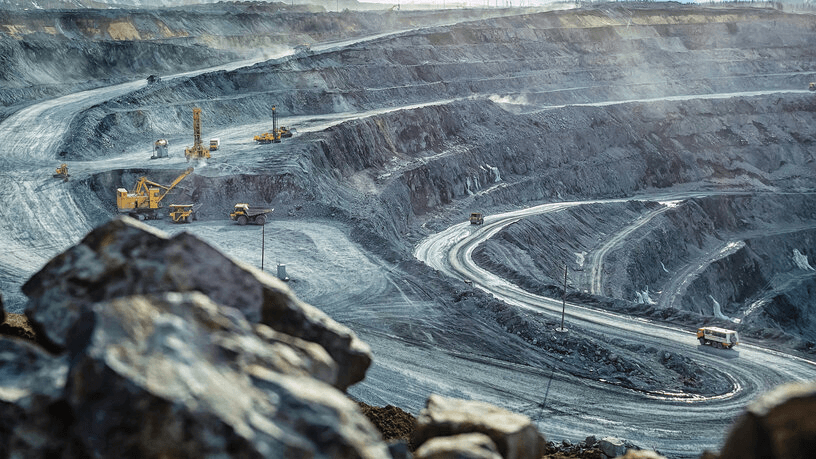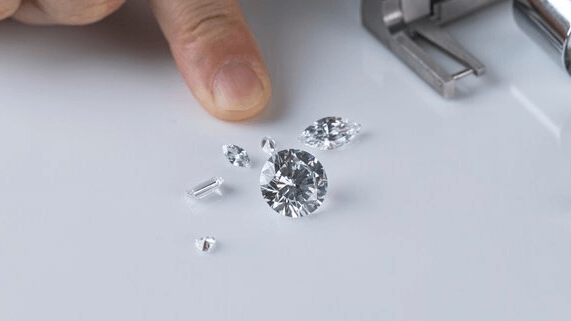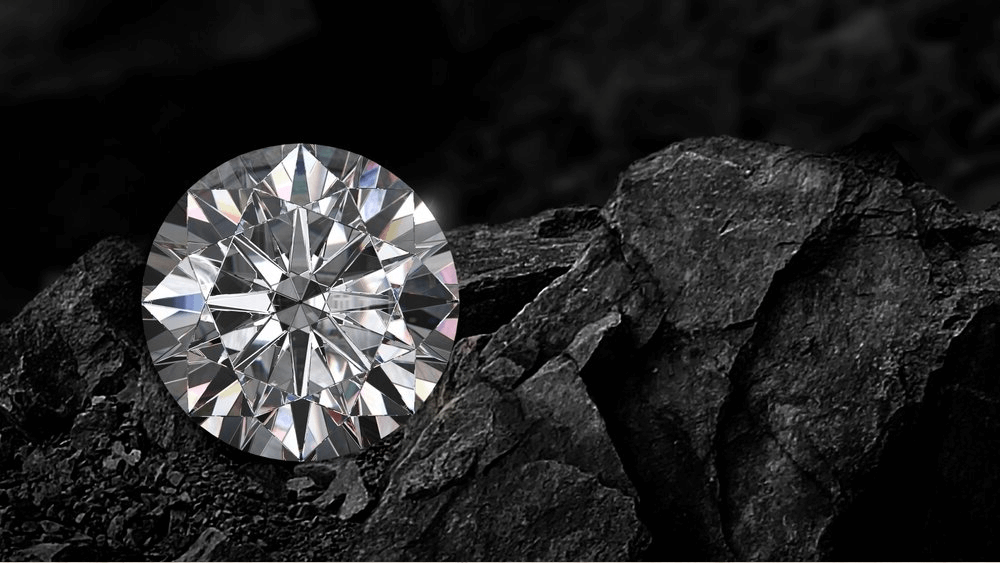Sierra Leone’s Diamond Mines: A Shocking Revelation

By Gary A.

Edited by Olivia H.
Published Dec 24, 2021
Edited on Mar 31, 2025
Sierra Leone’s diamonds, once marred by conflict, are now at the heart of a transformative journey, promising a future of renewal and ethical prosperity.

Navigate this guide:
- Sierra Leone Diamond Mines: 7 Quick Considerations When Buying a Diamond Engagement Ring
- Sierra Leone’s Diamond Industry: Past to Present
- The Evolution of Mining Practices: From Blood Diamonds to Ethical Mining
- Ethical Sourcing Through International Initiatives and Partnerships
- Overcoming the Stigma and Moving Forward
- Our Expert Take
- 10 FAQs
Before we dive deeper into the specifics, here are some practical tips to help guide your decision-making process:
Sierra Leone Diamond Mines: 7 Quick Considerations When Buying a Diamond Engagement Ring
Buying a diamond engagement ring is a significant investment, both emotionally and financially. When considering diamonds from Sierra Leone, it’s crucial to pay attention to specific aspects to ensure you make a responsible and informed choice. Here are practical tips to guide you through this process:
- Tip 1: Verify the Diamond’s Origin Traceability: Ensure the diamond’s traceability back to its mine in Sierra Leone. This not only guarantees the authenticity of its origin but also assures that it’s conflict-free. Kimberley Process Certification: Look for diamonds that come with Kimberley Process certification, which ensures the diamonds are not involved in funding conflict in war-torn areas.
- Tip 2: Understand the Socio-Economic Impact Contribution to Local Communities: Research or inquire how the diamond’s purchase contributes to the socio-economic development of local communities in Sierra Leone. Support Ethical Mining Practices: Choose diamonds from mines known for ethical practices, respecting miners’ rights, and providing fair wages and safe working conditions.
- Tip 3: Assess Environmental Sustainability Environmental Responsibility: Check if the mining practices at the Sierra Leone mine adhere to environmental sustainability standards, minimizing ecological damage. Rehabilitation Programs: Favor mines that engage in land rehabilitation post-mining to restore the environment.
- Tip 4: Demand Transparency and Disclosure Full Disclosure: Ask for full disclosure on the diamond’s journey from the mine to the market. This includes mining conditions, transportation, cutting, and polishing processes. Vendor Transparency: Choose a vendor who is open about their supply chain and can provide detailed information about the Sierra Leone diamond mine.
- Tip 5: Consider Community and Social Initiatives Community Investments: Support mines that invest in community development, such as healthcare, education, and infrastructure in Sierra Leone. Social Responsibility: Look for mining companies that actively participate in social responsibility initiatives, contributing positively to the communities they operate in.
- Tip 6: Examine the Quality with Care Quality Assurance: While ensuring ethical sourcing, don’t compromise on the quality of the diamond. Examine its cut, color, clarity, and carat, as these factors determine its value and beauty.
- Tip 7: Explore Artisanal and Small-scale Mining Options Artisanal Mining: Consider diamonds sourced from artisanal and small-scale mining (ASM) operations, which can directly benefit local miners and their families. Authenticity and Craftsmanship: ASM diamonds often have unique characteristics and stories, adding a layer of authenticity and craftsmanship to your engagement ring.
Now that you’ve got these practical tips, use Jeweler AI below to find the perfect engagement ring that suits your style and budget:
Sierra Leone’s Diamond Industry: Past to Present
Sierra Leone is a country of two halves. It is a place of incredible beauty, with sights ranging from lush and abundant rainforest to miles of woodland savanna, mountain ranges, mangrove swamp and grassland, and an abundant natural world of plants, animals, and other resources. At the same time, however, it is tied to a complex history of political and civil unrest, war, unemployment, and poverty.
While the Sierra Leone Civil War ended in 2002, the country is still feeling its effects severely. As of 2021, Sierra Leone was the fifth poorest country in the world based on gross national income (GNI) per capita, which stood at just $490 (USD). It is clear that the costs of the war are ongoing, with the country’s existing infrastructure falling far short of what is needed to improve the lives of massive portions of its population.
That’s not to say that improvements have not been seen. In fact, there are plenty of encouraging statistics and data from 21st-century Sierra Leone to suggest that change is happening – although much, much more is needed before some of the most vulnerable communities in the world can see (and, most importantly, benefit from) improvement.
One area that promises far more than it is currently able to give to the people of Sierra Leone is the diamond industry – although, for many people around the world, the prevailing image of Sierra Leone’s diamond industry is one of conflict, exploitation, and war.
Still, things are changing – and have been changing for some time now. There is far more to this beautiful country than a past of unrest, and now marks the time for the global diamond industry to recognize the improvement that has occurred, and will continue to happen, with the right investment.
The War-Torn Past and Its Impact on Diamonds
Diamonds were first officially discovered in Sierra Leone in 1930 and quickly fell under the control of the Sierra Leone Selection Trust. These diamonds were predominantly found in alluvial deposits – loose, sedimentary layers of earth containing loose diamonds, that have been carried away from their original source by rivers and other water sources.
By the mid-1950s, however, these alluvial deposits were mined by many artisan miners (individuals with no formal employment or professional equipment) and independent, small-scale mining companies. The scope of the country’s formal and informal mining operations continued to grow throughout the second half of the twentieth century, to the point where hundreds of thousands of people made their living from this resource.
Unfortunately, the income generated by these diamonds was not distributed effectively or fairly. Miners were largely unaware of their true value, and the income generated through this industry was predominantly felt by those in power, rather than the individuals living in poverty.
Then, by 1991, the country was gripped by a devastating civil war. Parts of the country that boasted high levels of alluvial deposits were quickly seized since these valuable stones proved to be an easily exploited source of income for funding war efforts. Again, individuals trying to make a living working as artisan miners suffered the most.
For many years, miners were highly vulnerable to exploitation. Men, women, and children had no other option but to work in appalling conditions, in the middle of ongoing violence as a result of the ongoing power struggles – the struggle for control over hundreds of millions of dollars worth of diamonds produced each year – between rebel groups.
Sierra Leone represented a major source of conflict diamonds – or, as they would later be known, ‘blood diamonds’. An industry that could have represented a major cornerstone of the country’s economy was not just laid to waste, but exploited at the expense of millions of civilians.
Emerging from the Shadows: Post-War Progress
While the war ended in 2002, Sierra Leone felt the impact as keenly as they felt the conflict itself. The country still held remarkable potential in its alluvial diamond deposits, but it was without any sort of formal structure, and still easily exploited – particularly in light of the extreme poverty that prevailed even after the fighting stopped.
With the release of the movie Blood Diamond and the documentary of the same name, more and more people became aware of the atrocities that occurred in Sierra Leone’s diamond mining areas. Exploitation and smuggling continued as the country struggled to regain a foothold in the aftermath of the civil war.
And, still, the potential for a regulated diamond industry was high. Further south, in countries like Namibia and Botswana, economies were flourishing as a result of the government’s involvement in mining efforts.
The story does, however, begin to improve – if only gradually. While slow and largely overlooked by the mainstream media, Sierra Leone’s attempts to gain a foothold in diamond production were (and are) proving successful. Between the end of the war and 2006, licenses for diamond mining in Sierra Leone had increased from the tens to the thousands; a sure sign that the country’s regulated and controlled diamond industry was growing.
Still, Sierra Leone is a poor nation with alluvial deposits scattered across miles and miles of land – much of which lacks any infrastructure. As a result, it is difficult to control overseas, and smuggling remains an issue. That, combined with the fact that the country became known for its conflict – and the blood diamonds that arose for it – meant that change was largely disregarded. While awareness was needed, it also led to a bad reputation – an intrinsic tie to the term ‘blood diamond’, and a lack of interest from investors and consumers around the world.
The Evolution of Mining Practices: From Blood Diamonds to Ethical Mining
While diamonds have represented a curse for Sierra Leone, that does nothing to change the fact that they could – and, in some cases, already do – represent the exact opposite. While the history is different, the future could be the same for Sierra Leone as it is for any of Africa’s more successful diamond-producing nations, with the right investment and approach from those who hold the key.
In 2001, two years before joining the Kimberley Process, the government of Sierra Leone created DACDF, which ensured that mining communities could start to see genuine benefits from the taxes generated when their diamonds were exported from the country. Between then and now, the level of legitimately mined diamonds has continued to increase. By 2006, more than $100 million was being generated through diamond exports per annum.
The Peace Diamond Alliance (PDA)
The Peace Diamond Alliance (PDA) ensures that the revenue generated by the diamond industry advances local development, educates miners about diamond values to prevent exploitation, and organizes diamond diggers into cooperatives to improve working conditions and protect human rights in Sierra Leone’s Kono mining region.
The Integrated Diamond Management & Policy (IDMP) program is funded by the U.S. Agency for International Development (USAID) and implemented in partnership with Management Systems International (MSI). IDMP has three components:
- Supporting local, national, and international efforts to implement policy reform in the diamond sector, including
– Providing analysis to inform decision-making
– Testing and developing practical models to influence policy
– Supporting improvements in the policy formulation process
– Encouraging the adoption of appropriate policies
– Support the capacity development of the government to implement applicable policies
- Establishment and support of the Peace Diamond Alliance (PDA), an organization that works to improve diamond management at the local level through cooperation among government, civil society, and business. The PDA was launched in December 2002 and registered as a Sierra Leonean organization in 2004. It is currently based in Kono District and Tongo Fields, though the community and government are pleading for expansion to other diamond mining and trading centers. IDMP provides organizational development support to the Executive Committees in Kono and Tongo Fields, as well as to key community-based organizations in the PDA. The PDA was awarded a grant in late 2004 from the Communities and Small-Scale Mining (CASM) Secretariat located at the World Bank to provide technical assistance to the PDA, to fund travel to meet with those engaged in artisanal mining in other countries, and to support various programmatic costs. The PDA was providing loans to artisanal diamond mining cooperatives in 2005 as part of the Integrated Diamond Management (IDM) program.
Activities:
– Conflict Management and Representing Community Interests in Policy
– Community/Industry Self-Regulation: Code of Conduct
– Raising Capital and Providing Loans to Artisanal Mining Cooperatives
– Supporting Human Rights and Broader Economic Development
– Providing Grants to PDA Civil Society Members - Piloting an innovative approach to artisanal diamond mining and marketing called Integrated Diamond Management (IDM.) IDM aims to complement traditional law-and-order approaches to combating illegality and exploitation in the diamond industry by changing the way the diamond resource is managed and marketed. IDMP, in partnership with the PDA and the Ministries of Mineral Resources and Trade & Industry, trains diggers in cooperative management, new mining technologies, and diamond valuation, as well as facilitating access to finance and better prices for mining cooperatives that agree to mine ethically, to incorporate environmental sustainability, and to track production from Earth to Export. The Rapaport Group and Kono’s Hope were two private sector PDA members that financed a total of five cooperatives in 2005 (the “pilot” phase.) Diamonds were purchased at values set by government evaluators, evaluating the four C’s of each diamond and how much a diamond is worth. The diamonds were then sold at tender internationally, and any excess profits from the tender were returned to the diggers. The British NGO, Global Witness, monitored the system. Twenty-five artisanal diamond miners’ cooperatives were registered, each with approximately 50 members.

Ethical Sourcing Through International Initiatives and Partnerships
In 2018, the mining group De Beers established an ethical sourcing pilot scheme in Sierra Leone, designed to put traceability in the hands of the artisanal and small-scale miners themselves. As of 2021, that number had climbed to 160. This technology, while relatively new now, promises to be combined with blockchain in the future for an infallible record that leads vendors back to the miners who first brought their diamonds to the surface.
As a result of this change, it is entirely possible for vendors to begin sourcing responsibly and ethically mined diamonds from Sierra Leone – and to support a future of economic and personal growth within the country.
Initiatives for Local Development
From countries further down the road in terms of establishing strong and resilient diamond industries, there are countless examples of the good diamonds can bring. Education, roads, hospitals – even the most basic necessities like running, clean water, and electricity – can become more of a possibility with a stable economy.
It is vital to remember that diamonds represent a major export for Sierra Leone, and that finding the tools and investment needed to realize the full potential of this sector promises a lot for the country.
Overcoming the Stigma and Moving Forward
Sierra Leone represents a country still trying to shed the weight of a long and difficult past. Far beyond its diamond sector, it is still reeling from years of devastating conflict and corruption, and, as you might expect, the greatest struggle is felt by the individual.
It’s true that, decades ago, the market was flooded with conflict diamonds – many of which came from Sierra Leone and the artisan miners who were exploited and forced to work under rebel groups looking to fund conflict. It’s also true that, for a lot of people who recall Sierra Leone’s days of civil war, reimagining the country’s diamond industry as one defined by growth, development, opportunity, and sustainable economic growth will take some time.
That’s not to say, however, that it cannot happen – or that it isn’t already happening in parts of the country. As of 2021, the high potential of Sierra Leone’s alluvial diamonds – potential that has been widely discussed across the global industry – is beginning to pay off for artisan and small-scale mining operations. A key point raised in the All That Glitters seminar, held in 2020 by the Initiatives in Arts and Culture, was that overlooking the issues faced by artisan and small-scale miners was simply not an option.
Our Expert Take
One of the greatest setbacks Sierra Leone’s diamond industry faces is stigma – memories of a time when corruption outperformed licit mining activities. But picturing the country as one that is trapped under its own weight doesn’t help it to repair, improve, and create entirely new opportunities for economic growth.
True, there is a way to go, but there is a right and good way of getting there with the right support and investment from the global diamond industry.
10 FAQs
- Q: Are diamonds from Sierra Leone conflict-free?
- A: Most diamonds from Sierra Leone are conflict-free, especially those certified under the Kimberley Process. However, it’s essential to verify each diamond’s traceability and certification to ensure it’s ethically sourced.
- Q: How can I ensure the diamond I buy supports local communities in Sierra Leone?
- A: Look for diamonds from companies that transparently invest in Sierra Leone’s local communities through healthcare, education, and infrastructure development.
- Q: What is the Kimberley Process, and why is it important?
- A: The Kimberley Process is a certification scheme that aims to prevent conflict diamonds from entering the mainstream market. It’s important because it ensures that the diamonds are mined and sold responsibly, not funding armed conflict.
- Q: Can I find high-quality diamonds from Sierra Leone?
- A: Yes, Sierra Leone is known for producing high-quality diamonds. Ensure to check the 4Cs (cut, color, clarity, and carat) for quality assessment.
- Q: Are there environmentally sustainable diamond mines in Sierra Leone?
- A: Yes, some diamond mines in Sierra Leone adhere to environmental sustainability practices, but it varies. Research the specific mine’s environmental policies and rehabilitation efforts.
- Q: What is the socio-economic impact of purchasing a diamond from Sierra Leone?
- A: Purchasing diamonds from Sierra Leone can positively impact local economies, supporting community development and providing fair wages to miners when sourced ethically.
- Q: How can I verify the origin of a diamond from Sierra Leone?
- A: Ask for a diamond’s certificate of origin, which should trace back to its mine in Sierra Leone. This certification typically accompanies diamonds that are part of the Kimberley Process.
- Q: Do Sierra Leone diamonds come with any unique characteristics?
- A: Diamonds from Sierra Leone are often praised for their quality and can exhibit unique characteristics based on their alluvial origin, but individual stones vary greatly.
- Q: Is it possible to buy diamonds directly from Sierra Leone mines?
- A: Direct purchase from mines isn’t common for individual buyers. It’s more practical to buy through reputable vendors who source their diamonds from Sierra Leone.
- Q: How does the artisanal and small-scale mining sector in Sierra Leone affect diamond quality?
- A: Artisanal and small-scale mining can produce high-quality diamonds, though these diamonds might not always be graded. They can be unique but require careful selection for quality assurance.
Discover the ethical brilliance with Jeweler AI – your gateway to Sierra Leone’s transformed diamond mines. Explore our AI-powered selection for the perfect conflict-free gem.
FOLLOW-UP GUIDE SERIES








